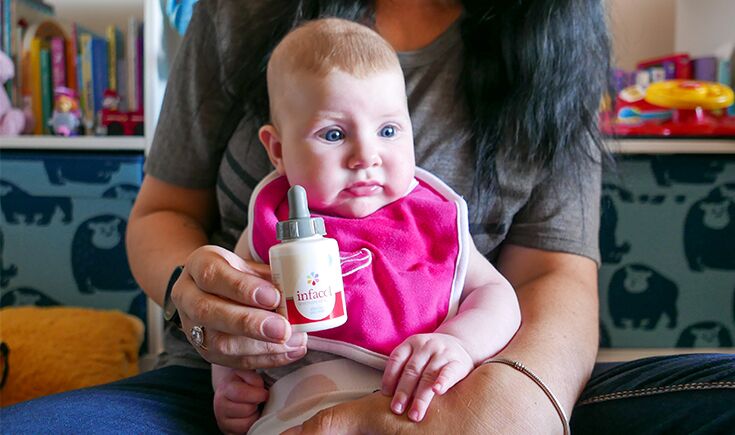How Much Infacol Can You Give a Baby: A Complete Guide
Infacol can be given to a baby as often as required, before each feed, regardless of the number of feeds in a day. It is safe to use and its active ingredient, simeticone, does not get absorbed into the baby’s body.
Understanding Infacol And Its Uses
Infacol is a widely used medication for babies that helps relieve colic, bloating, and wind. It contains simeticone as its active ingredient, which works by breaking down the gas bubbles in the baby’s stomach. In this section, we will delve deeper into what Infacol is, how it works, and the benefits of using it for your baby.
What Is Infacol?
Infacol is a safe and effective medicinal product specially formulated for infants from birth onwards. It is available in the form of drops that are easy to administer. The main component of Infacol, simeticone, is a type of anti-foaming agent that helps reduce the surface tension of the gas bubbles in your baby’s tummy. This enables the gas bubbles to combine, making it easier for your baby to bring them up or pass them through their digestive system.
How Does Infacol Work?
Infacol works by reducing the surface tension of the gas bubbles in your baby’s stomach, allowing them to combine and be expelled more easily. By breaking down the gas bubbles, Infacol helps relieve symptoms of colic, such as excessive crying, fussiness, and discomfort. It does not get absorbed into your baby’s body, making it safe for regular use.
Benefits Of Using Infacol For Babies
- Relieves colic: Infacol has been proven to effectively relieve colic symptoms in babies. By reducing the gas bubbles in your baby’s stomach, it can help alleviate the discomfort and pain associated with colic, allowing your little one to settle and sleep better.
- Eases bloating: Infacol helps break down the gas bubbles in your baby’s tummy, relieving bloating and reducing the discomfort. This can help your baby feel less gassy and more comfortable after feeds.
- Calms fussiness: Colic and gas can often make babies fussy and irritable. Using Infacol can help calm your baby by reducing the gas bubbles and relieving the associated discomfort, allowing them to be more content and happy.
- Safe and gentle: Infacol is a gentle yet effective remedy for colic and gas in babies. It has been extensively tested and is suitable for regular use. The drops are easy to administer, and the active ingredient, simeticone, is not absorbed into your baby’s body.
Using Infacol for your baby can be a game-changer in managing colic symptoms and providing relief. Always consult your pediatrician before introducing any new medication or making changes to your baby’s feeding routine.
Safe Dosage Of Infacol For Babies
As a parent, it can be concerning when your baby experiences discomfort due to colic or trapped wind. Infacol is a popular option for relieving these symptoms in babies. However, it is important to know the safe dosage of Infacol to ensure your baby’s well-being. In this article, we will explore the recommended dosage of Infacol for babies, the factors to consider when determining the dosage, and whether a newborn can have too much Infacol.
Recommended Dosage Of Infacol For Babies
Infacol should be given to your baby before each feed to help alleviate colic and trapped wind. The recommended dose of Infacol is as follows:
- For infants under 1 month old: 0.5 ml per dose.
- For infants over 1 month old: 1 ml per dose.
It is important to adhere to the recommended dosage and always consult with your healthcare provider before administering any medication to your baby.
Factors To Consider When Determining The Dosage
While the recommended dosage of Infacol provides a general guideline, there are factors to consider when determining the dosage for your baby. Some of these factors include:
- Age of the baby: Infacol dosage may vary depending on your baby’s age.
- Weight of the baby: In some cases, the weight of the baby may influence the dosage.
- Recommendation from healthcare provider: Your healthcare provider may provide specific instructions on the dosage based on your baby’s individual needs.
Always consult with your healthcare provider for personalized advice on the appropriate dosage for your baby.
Can A Newborn Have Too Much Infacol?
Infacol is considered safe for use in newborns. Since Infacol’s active ingredient, simeticone, is not absorbed into your baby’s body, the risk of overdose is minimal. However, it is always important to follow the recommended dosage and consult with your healthcare provider if you have any concerns.
In Conclusion
Understanding the safe dosage of Infacol for babies is essential for providing relief from colic and trapped wind. By following the recommended dosage, considering the factors that influence the dosage, and consulting with your healthcare provider, you can ensure the well-being of your baby.
Administering Infacol To Your Baby
Administering Infacol to your baby is safe as it can be given before each feed, regardless of the number of feeds in a day. The active ingredient, simeticone, does not get absorbed into the baby’s body.
How And When To Give Infacol To Your Baby
Infacol is a commonly used colic relief medication for babies. It contains simeticone, which helps to relieve trapped gas in the digestive system. When it comes to giving Infacol to your baby, it is important to follow the recommended dosage and administration guidelines. Here’s a step-by-step guide on how and when to give Infacol to your little one:
- Shake the bottle of Infacol well before use.
- Using the provided dropper, draw up the correct dose of Infacol.
- Administer the dose directly into your baby’s mouth, aiming for the inner cheek.
- Infacol can be given before each feed, regardless of how many times your baby is being fed throughout the day.
- Make sure to give Infacol at least 30 minutes before your baby’s feed to allow it to work effectively.
Tips For Administering Infacol Effectively
Administering Infacol to your baby can sometimes be a challenging task. Here are some tips to help you administer Infacol effectively:
- Try to give Infacol when your baby is calm and not too hungry.
- Hold your baby in an upright position while administering the dose to reduce the risk of choking.
- If your baby is resisting taking Infacol, you can mix it with a small amount of breast milk or formula to make it more palatable.
- Make sure to clean and sterilize the dropper after each use to maintain hygiene.
- If you’re unsure about the correct dosage or have any concerns, consult your pediatrician.
How Long To Continue Using Infacol?
The duration for which you should continue using Infacol depends on your baby’s symptoms and response to the medication. In most cases, Infacol can be used for several weeks or until your baby’s colic symptoms improve. However, it’s important to consult with your pediatrician for personalized advice.
Potential Side Effects And Precautions
When using Infacol for your baby, it is important to be aware of the potential side effects and take necessary precautions to ensure their safety and well-being. Understanding these factors can help you make informed decisions and provide the best care for your little one.
Common Side Effects Of Using Infacol
While Infacol is generally safe to use, it is important to be aware of the common side effects that may occur. These side effects are usually mild and do not cause any serious harm to your baby. Some of the common side effects of using Infacol include:
- Gentle rumbling or tummy noises
- Increase in saliva production
- Slight change in the color of stools
If you notice any of these side effects, there is no need to worry. They are temporary and will typically resolve on their own as your baby’s body adjusts to the medication.
Safety Precautions And Guidelines While Using Infacol
While Infacol is considered safe for babies, it is important to follow certain safety precautions and guidelines to ensure the well-being of your little one. Here are some safety measures to keep in mind:
- Always read and carefully follow the instructions provided on the packaging or as directed by your healthcare professional.
- Administer the recommended dosage of Infacol to your baby before each feed. Do not exceed the recommended dose.
- Ensure proper hygiene by washing your hands before handling the medication or administering it to your baby.
- Store Infacol in a cool, dry place away from direct sunlight and out of reach of children.
- Do not use Infacol if your baby is allergic to any of its ingredients. If you suspect an allergic reaction, discontinue use and consult a healthcare professional.
When To Consult A Healthcare Professional
While Infacol is generally safe, there are instances where it is advisable to consult a healthcare professional. If you notice any of the following symptoms or have concerns about your baby’s health, seek medical advice:
- Severe or persistent abdominal pain
- Excessive vomiting or diarrhea
- Blood in stools
- Difficulty breathing or swallowing
- Unusual changes in behavior or appetite
Remember, your healthcare professional is the best resource for guidance and support regarding your baby’s health. They can provide personalized advice based on your baby’s specific needs and circumstances.
Alternatives To Infacol For Colic Relief
If your baby suffers from colic, you may be wondering about alternative options for relief other than Infacol. While Infacol is a popular choice, there are other remedies available that can help soothe your baby’s colicky symptoms. In this article, we will explore some of the alternatives to Infacol for colic relief.
Overview Of Alternative Colic Relief Options
When it comes to providing relief for colicky babies, there are a few options you can consider. These alternatives can be just as effective in relieving your baby’s discomfort and helping them settle down.
Here is an overview of some alternative colic relief options:
- Swaddling: Swaddling your baby in a comfortable blanket can help recreate a womb-like environment, providing a sense of security and calmness.
- Changing feeding techniques: Sometimes, colic can be caused by swallowing air during feedings. Trying different feeding positions and making sure your baby is properly latched can help reduce air intake.
- White noise: Using white noise machines or even simply playing soothing sounds, such as ocean waves or rain, can help drown out excessive environmental stimuli and create a relaxing atmosphere for your baby.
- Massage: Gentle massage techniques can help stimulate digestion and alleviate gas and discomfort in your baby’s tummy. Always consult with a pediatrician or a certified infant massage therapist for guidance on safe techniques.
- Probiotics: Some studies suggest that probiotics, specifically strains like Lactobacillus reuteri, may help improve colic symptoms by promoting a healthy gut microbiome. Consult with your pediatrician before introducing any probiotics to your baby.
Is Gripe Water Better Than Infacol?
Many parents wonder if gripe water is a better option than Infacol for relieving colic symptoms. Gripe water is a herbal remedy made from a combination of herbs and natural ingredients. However, it’s important to note that the effectiveness of gripe water varies from baby to baby.
Some parents find gripe water to be helpful in soothing their baby’s colic, while others may not see significant improvement. It’s best to consult with your pediatrician before using gripe water or any other alternative remedy to ensure it is safe and appropriate for your baby.
Comparing Different Colic Drops For Babies
When looking for colic drops as an alternative to Infacol, you may come across different options in the market. Here are a few popular colic drops for babies:
| Colic Drop Brand | Active Ingredient |
|---|---|
| Colicaid | SIMETHICONE |
| Woodward’s Gripe Water | Dill Oil and Sodium Bicarbonate |
| Colic Calm Gripe Water | Charcoal, Fennel, and Ginger |
Each of these colic drops may have different ingredients and formulations. It’s important to read the instructions and consult with your pediatrician before using any of these drops to ensure they are suitable for your baby. Remember that every baby is unique and may respond differently to various remedies.
As always, it is crucial to consult with your pediatrician before trying any alternative colic relief options or changing your baby’s current routine. Your pediatrician will be able to provide personalized guidance based on your baby’s specific needs and medical history.

Credit: www.amazon.com
Frequently Asked Questions On How Much Infacol Can You Give A Baby
Can A Newborn Have Too Much Infacol?
Infacol can be used as often as needed before each feed without any risk of overdose in newborns.
Does Infacol Work Immediately?
Infacol can be used before each feed, and its active ingredient doesn’t absorb into the baby’s body.
Is Gripe Water Better Than Infacol?
Gripe water may be more effective than Infacol, as it usually helps with burping. However, some people still use Infacol because it takes time to work. Use gripe water before each feed, while Infacol should be used consistently for several days.
How Many Times Can I Give My Baby Colic Drops?
You can give your baby colic drops as often as required, before each feed regardless of how many times you feed your baby during the day. The active ingredient, simeticone, is not absorbed into your baby’s body.
Conclusion
To summarize, Infacol can be given to a baby before each feed, and there is no limit on the number of times it can be used in a day. The active ingredient, simeticone, does not get absorbed into the baby’s body.
It is important to use Infacol consistently for several days to achieve the best results. Remember to consult a healthcare professional if you have any concerns or questions about using Infacol.








